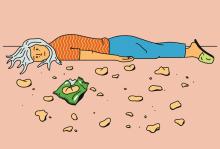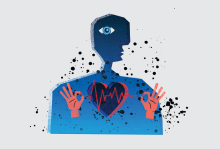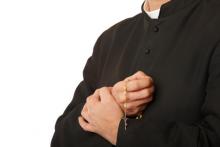stress

WHAT DO YOU MEAN, “How to keep going,” you may ask? I’m fine, you may say. The increasingly fraught political landscape, the ominous signs of climate change, the erosion of voting rights, the crushing “invisible hand” of global capitalism, and a lack of space to collectively process any of the above — these are all things that are totally fine and normal and do not bother you. Your eye is not twitching right now as you say this.
Hush, you. I made a list of five easy steps to help you keep on keeping on. Read it and weep. I mean, stop weeping.

WHAT BETTER MOMENT to have a medical stress test than during this most stressful of times. Yes, there have been other stressful periods in our nation’s history. For our “greatest generation,” it was Pearl Harbor. For their children, it was the last episode of Seinfeld. (Yes, we’re shallow, but it’s not our fault. We baby boomers were over-loved by the greatest generation. So shame on them!)
But nothing compares to living on the brink of war, with a planet on fire, and no confidence in our leadership (especially after my sweet dream about President Martin Sheen). These days, one wonders why stress tests are given in a medical office when mine could just be in the kitchen, where physicians could simply monitor me as I read the morning newspaper. An EKG tracking my rage sweats before I get to the sports page could be useful in determining a treatment plan, which should include at least switching to a monthly newspaper subscription, if there is such a thing.
But when, in the course of human events, you get chest pains, you do what the doctor tells you. Which is get on a treadmill. It seems odd that, in this age of technological innovation, such a crude and simple contraption still provides the best window into one’s cardiological health. And the doctor’s procedures are similarly tedious and unchanged. I start walking at a comfortable pace, then the doctor increases the speed, then a little more, and a little more. Then the angle is increased, then a little more, until I’m gasping for breath and convinced of one thing: This doctor is trying to kill me.

Many people fear death. It’s an understandable fear. And one that’s socially acceptable.
But shouldn’t we also admit that living can be scary as hell, too?
As any fan of The Walking Dead and other apocalyptic fiction knows, it doesn’t take much for the lines between order and chaos, between civility and mayhem, and between trustworthiness and falsehood to be exposed as thinner than advertised.
We aren’t given a choice. We navigate a world in which we exercise little real control.
Co-pilots aren’t supposed to crash commercial jets.
States can't just grant individuals and businesses the right to discriminate against under-protected groups under some squishy definition of "religious freedom," can they?
We may never learn where those two-hundred-plus Nigerian girls were taken, the ones kidnapped from their school — their school! — nearly one year ago.
Why does NIMBYism derail so many good-faith and promising efforts to help rehabilitate released felons and other at-risk populations?
What part of the world that I can barely locate on a map has my country decided to bomb for me today?
Confidence and fear travel through our veins, compelling us, as they act out their odd, entangled relationship. We rarely have the luxury to see where our choices will lead us. We’re swept along by others’ choices and barely detectable forces.
Anxiety is more than a devious marketing strategy in cable news channels’ portfolios; it arises from life’s uncertainties. It’s a way our bodies ask whether we can trust those yearnings that give birth to our hopes for a society that truly flourishes.
Who doesn’t live by some kind of faith? Such “faith” can be a reliance on effort and intelligence, a willingness to surrender to risk, a retreat into the security of privilege, a decision to live for others, or a resigned acceptance that at least we’ll have company when disaster strikes. What, finally, compels us forward?

I was among millions across the globe wrapped up in the glee of Pharrel William’s song, “Happy.” I first heard it while watching Despicable Me 2 with my family last year. As the credits rolled I remember making a mental note to add it to my workout playlist.
Pharrel even released a 24-hour video of the song on YouTube for millions to enjoy globally – creating a sort of time released happy capsule that was just a click away.
I thought about how this “Happy” anthem struck a chord in our world’s collective unconscious. “Could it be a sign that all of us, the human family, crave deeper joy and some levity?”
I think faith-based communities can discuss this for years to come at a time where joy is a necessity more than a luxury, and ministers are flaming out quicker than ever, and according to a New York Times article, suffer from depression “at rates higher than most Americans.”
Maintaining a sense of joy is then vital for my own work, especially since I lean toward New York-bred cynicism and incredulity. Activism can be rewarding, yet also extremely discouraging at times. Change can seem incremental at best, and the issues are much bigger than any one person or institution can handle. Making joy a vital ingredient in the active life of faith, within the soul of activity.
I’ve been considering three approaches in cultivating joy, a God-given, buoyant energy, in the midst of some weighty work.

Most members of the clergy are taught to put the physical and spiritual needs of others first, but that self-denial may be harmful to their own health, according to a new Duke University study.
Studies of United Methodist pastors in North Carolina found high rates of chronic disease and depression, and researchers worry it can be difficult to convince clergy to seek help.
To address these unique problems, Duke Divinity School's Clergy Health Initiative developed a program to provide preventative care in a spiritual context.